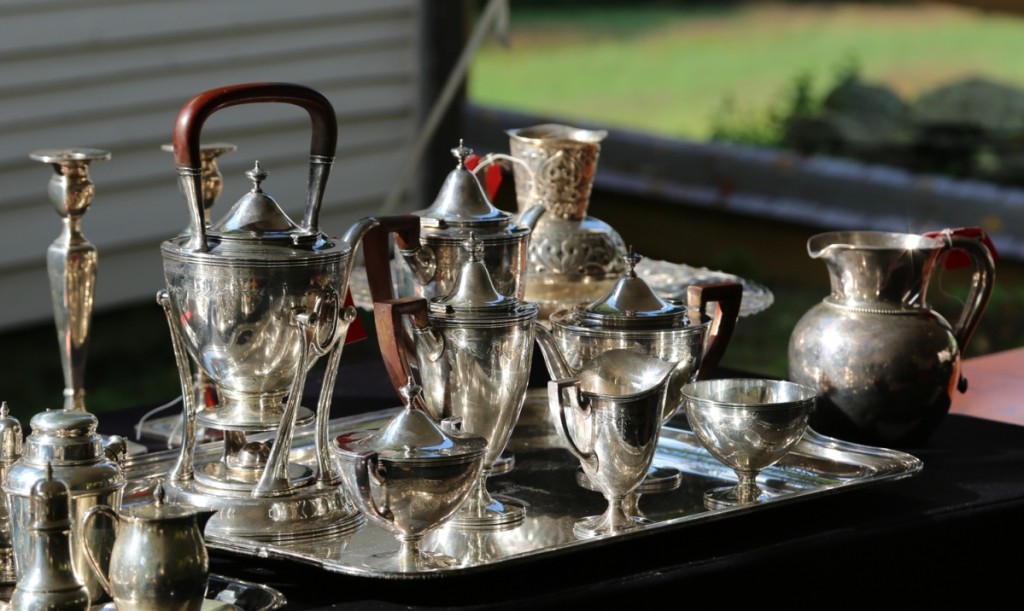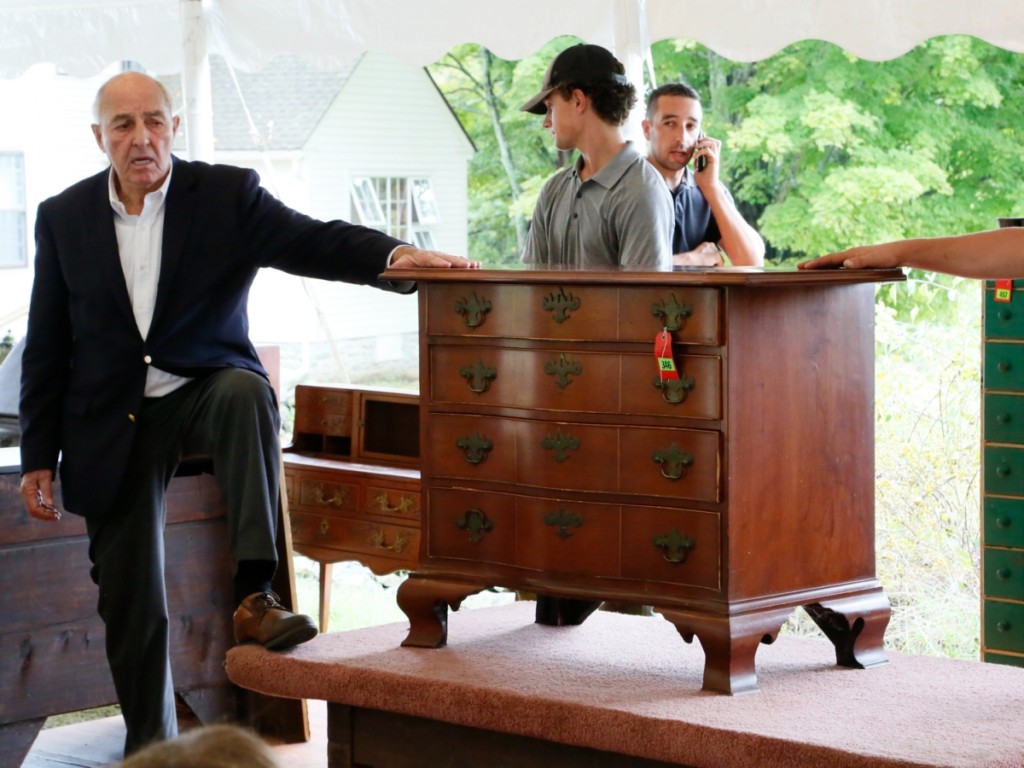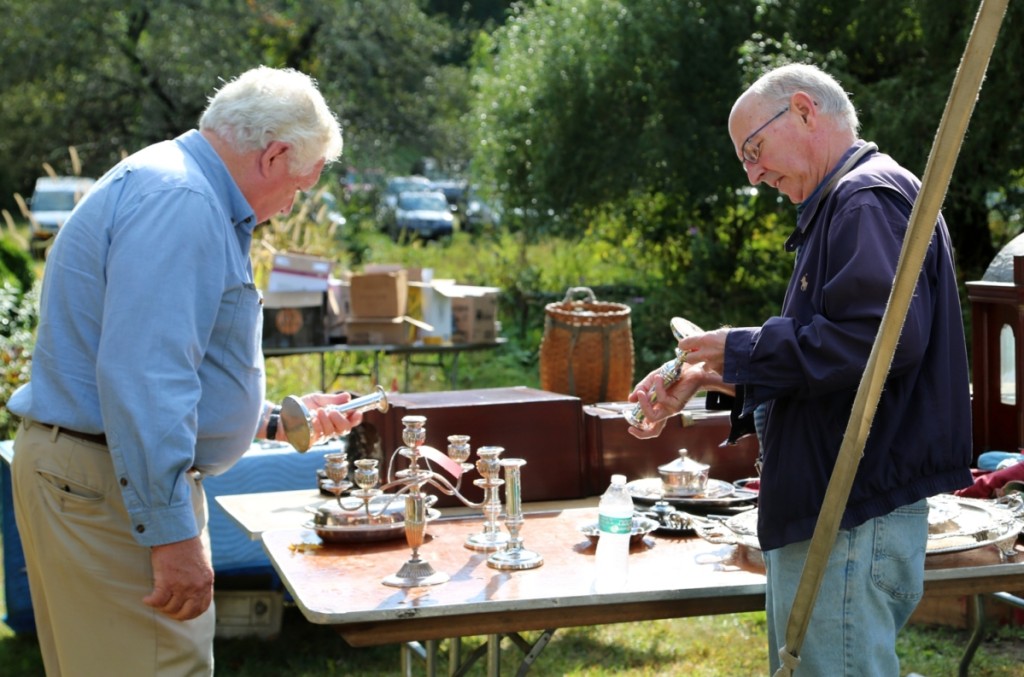
Corcoran said this Tiffany & Co eight-piece sterling silver tea and coffee service weighed in excess of 25 pounds. It brought the highest price of the sale at $14,400.
Review and Photos by Greg Smith
HAMPTON, CONN. – Mike Corcoran is the kind of guy you can hear before you see. When the auctioneer of Gustave J.S. White pulled into the estate at Popover Hill farm about 45 minutes prior to auction on October 3, he did not get halfway down the driveway before his window rolled down and “Dan!” came bellowing out. “Steve! Hey bud, how are you?” he continued. After he shouted greetings to a few more people, like friends seeing each other across the room, he continued down the dirt driveway to the field that had been freshly mowed to accommodate parking.
The sale offered the estate of Leila Fiske Ostby, who passed away in February of 2018. Daughter Edith Konesni recalls an idyllic childhood growing up in the antique 1809 house on the farm with her two siblings. The family operated a Christmas tree farm in the winter. “As children, we would walk people out, or sometimes horse and sleigh people out, to get their trees. My mother would have her shop open and would be selling during those times.” Ostby was a metalsmith, trained at the School of the Museum of Fine Arts, Boston, and she was the director of the Connecticut Guild of Craftsmen for a number of years. She was also a sculptor.
The approximately 200 lots in the sale were the sum of pieces passed down through both sides of the family, both with long histories in New England and the Boston-area.
Ostby’s maiden name is indeed traceable to the Boston arts landscape, as she was the niece of famous painter Gertrude Fiske. In April of this year, Antiques and The Arts Weekly featured a cover story on “Gertrude Fiske: Modern Master,” the artist’s comprehensive exhibition at the Discover Portsmouth Center, which ran through September 30.
While no Fiske paintings turned up in the sale, a good selection of American furniture, painted boxes, landscape and maritime paintings, pictures, Louis Vuitton trunks and other pieces were pulled from the house to entice buyers.
Corcoran’s sales are an anomaly. Buyers do not receive a bid card; they instead shout out their name, and if you buy enough, Corcoran will remember it. He remembers most of them anyway.

This was the top chest of the day. Corcoran thought it was from Massachusetts, but the buyer believed it was from Northwest Connecticut. It took $4,800.
The auctioneer has a unique sense of style. His motto, “always onsite, never online,” is not so much a buck of the market trend, but rather a personal choice. Corcoran runs his auctions the only way he knows how to: in a very conversational and personal way. He seems to know the majority of the audience sitting in the seats, and he remembers what they buy and who he should look at for certain lots.
“Mike has gone back generations in our family,” Konesni said, as she recalled selling with Corcoran when her grandmother passed away in the mid-90s. “He was the natural person to call. He knew the collection – had already assessed it and appraised it years ago. It was fun to see how excited he got when we took him around and showed him what we had again.”
Adjacent to the barn, which was set up for the exhibition, was a large tent with a stage, seating and many of the better items in the sale.
When Antiques and The Arts Weekly spoke to Corcoran before the sale got underway, he said it was a good quality auction, particularly the first half.
“There’s an old saying,” he said. “Who’s here, and how long do they stay?”
The sale got underway with a selection of rugs, which sold to three or four different bidders who crowded around Corcoran. At the top was a 5-by-8-foot Kazak that brought $720.
From there, Corcoran stepped onto the center stage under the tent and began the general sale. Bidding continued with a pair of Louis Vuitton steamer trunks. Corcoran quipped that when presented with two of the same objects, an auctioneer should always sell the better one first. With that, the first one batted between two bidders before it sold for $6,300. Corcoran looked at the remaining trunk and then joked, “And you should always sell the better one second.” It brought $5,400. Both were bought by dealer Heidi Stevens, owner of Re in North Kingstown, R.I.
Following behind was an eight-piece Tiffany & Co silver tea and coffee service that weighed in excess of 25 pounds. The set was from Mrs Davis, an acquaintance of the Ostbys from Hampton who asked to have it added into the sale. Corcoran said, “Mrs Davis took me around her home and showed me a couple of chairs. And then she brought me into the closet, and here’s this tea set. It’s the best I’ve ever seen.” Corcoran was able to start the bidding at $8,500 before it stalled at $14,400. The auctioneer turned to Mrs Davis, who was present, and asked if she was happy. She said, “sure, that’s pretty good,” and Corcoran hammered it down to a phone bidder. The phone bidder then got on the phone with Mrs Davis and she obliged him or her to contact her for provenance if they wished. That’s just the kind of thing that happens at a Corcoran sale.

A couple of buyers take a look at some of the weighted silver candlesticks on the tables outside the tent.
There was plenty of other silver in the sale. In the 1950s, Ostby’s husband, Rad, went to Chile to set up a manufacturing plant for the company he worked for. While there, he brought back a number of Chilean silver repoussé pieces, including a bowl, pitcher and plate, which brought $960. A Gorham silver demitasse tea set with a pitcher and ten cups took $1,080. A Tiffany sterling bowl brought $360.
A number of furniture pieces stood out in the sale. At the top was a four-drawer chest that Corcoran had thought was from Massachusetts, but the buyer believed it was from Northwest Connecticut. It brought $4,800. A nice serpentine-front chest went to a buyer in the crowd for $3,120. Following behind was a Queen Anne lowboy, which sold to an absentee bidder for $1,800.
Finishing at $3,600 was a case clock by Massachusetts maker Daniel Munroe. Munroe trained under Simon Willard in Roxbury, N.H., for seven years before he started Daniel Munroe & Co with his brothers, Nathan and William, in Concord, Mass. They made clocks together for six years between 1798 and 1804. Before the sale, Corcoran said he thought it was going to bring $4,000.
A number of other pieces found good results. A nice, painted country box went out at $3,000 between two floor bidders. A large apothecary chest took $1,800. A nice sign labeled for W.P. Witt Inn, established in 1829, caught $840 from the phones; it featured original paint and had a painted eagle on it with the word “LIBERTY” above.
There were two modern lots in the sale that spoke to the breadth of accumulation. A Charles and Ray Eames 670 lounge chair with 671 ottoman in black leather took $1,800. A pair of Mies van der Rohe MR20 chairs brought $240.
Two paintings by Providence, R.I., artist George William Whitaker were some of the highest of the sale. The higher of the two went out at $1,020, while the other sold for $480.
Following the sale, Konesni relayed that she was happy with the results. “It was great to work with Mike, and he knows his business,” she said.
All prices reported include the buyer’s premium. The Gustave J.S. White Company auction galleries are at 1674 and 1676 East Main Road. A real estate company of the same name is based in Newport. For more information, 401-841-5780.























